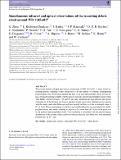Files in this item
Simultaneous infrared and optical observations of the transiting debris cloud around WD 1145+017
Item metadata
| dc.contributor.author | Zhou, G. | |
| dc.contributor.author | Kedziora-Chudczer, L. | |
| dc.contributor.author | Bailey, J. | |
| dc.contributor.author | Marshall, J. P. | |
| dc.contributor.author | Bayliss, D. D. R. | |
| dc.contributor.author | Stockdale, C. | |
| dc.contributor.author | Nelson, P. | |
| dc.contributor.author | Tan, T. G. | |
| dc.contributor.author | Rodriguez, J. E. | |
| dc.contributor.author | Tinney, C. G. | |
| dc.contributor.author | Dragomir, D. | |
| dc.contributor.author | Colon, K. | |
| dc.contributor.author | Shporer, A. | |
| dc.contributor.author | Bento, J. | |
| dc.contributor.author | Sefako, R. | |
| dc.contributor.author | Horne, K. | |
| dc.contributor.author | Cochran, W. | |
| dc.date.accessioned | 2016-11-18T11:30:14Z | |
| dc.date.available | 2016-11-18T11:30:14Z | |
| dc.date.issued | 2016-12-21 | |
| dc.identifier | 247732360 | |
| dc.identifier | a8ca9728-81ab-4938-bfde-2a12aa32e96e | |
| dc.identifier | 85010028855 | |
| dc.identifier | 000393568200068 | |
| dc.identifier.citation | Zhou , G , Kedziora-Chudczer , L , Bailey , J , Marshall , J P , Bayliss , D D R , Stockdale , C , Nelson , P , Tan , T G , Rodriguez , J E , Tinney , C G , Dragomir , D , Colon , K , Shporer , A , Bento , J , Sefako , R , Horne , K & Cochran , W 2016 , ' Simultaneous infrared and optical observations of the transiting debris cloud around WD 1145+017 ' , Monthly Notices of the Royal Astronomical Society , vol. 463 , no. 4 , pp. 4422-4432 . https://doi.org/10.1093/mnras/stw2286 | en |
| dc.identifier.issn | 0035-8711 | |
| dc.identifier.other | ArXiv: http://arxiv.org/abs/1604.07405v2 | |
| dc.identifier.uri | https://hdl.handle.net/10023/9841 | |
| dc.description.abstract | We present multi-wavelength photometric monitoring of WD 1145+017, a white dwarf exhibiting periodic dimming events interpreted to be the transits of orbiting, disintegrating planetesimals. Our observations include the first set of near-infrared light curves for the object, obtained on multiple nights over the span of one month, and recorded multiple transit events with depths varying between ~20 to 50 per cent. Simultaneous near-infrared and optical observations of the deepest and longest duration transit event were obtained on two epochs with the Anglo-Australian Telescope and three optical facilities, over the wavelength range of 0.5 to 1.2 microns. These observations revealed no measurable difference in transit depths for multiple photometric pass bands, allowing us to place a 2 sigma lower limit of 0.8 microns on the grain size in the putative transiting debris cloud. This conclusion is consistent with the spectral energy distribution of the system, which can be fit with an optically thin debris disc with minimum particle sizes of 10 +5/-3 microns. | |
| dc.format.extent | 1715799 | |
| dc.language.iso | eng | |
| dc.relation.ispartof | Monthly Notices of the Royal Astronomical Society | en |
| dc.subject | Planets and satellites: individual: WD 1145+017 | en |
| dc.subject | White dwarfs | en |
| dc.subject | QB Astronomy | en |
| dc.subject | QC Physics | en |
| dc.subject | NDAS | en |
| dc.subject.lcc | QB | en |
| dc.subject.lcc | QC | en |
| dc.title | Simultaneous infrared and optical observations of the transiting debris cloud around WD 1145+017 | en |
| dc.type | Journal article | en |
| dc.contributor.institution | University of St Andrews. School of Physics and Astronomy | en |
| dc.identifier.doi | https://doi.org/10.1093/mnras/stw2286 | |
| dc.description.status | Peer reviewed | en |
This item appears in the following Collection(s)
Items in the St Andrews Research Repository are protected by copyright, with all rights reserved, unless otherwise indicated.

